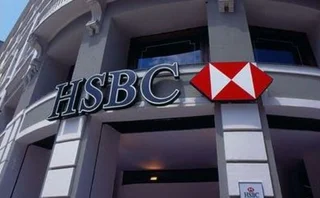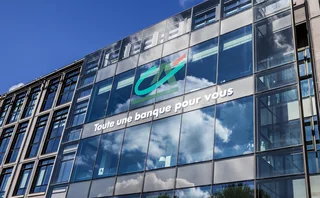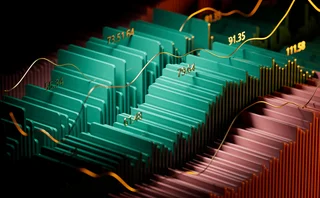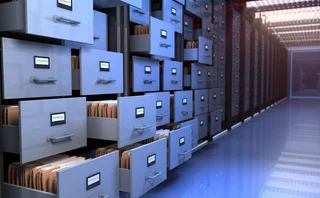
OTC FX options market gears up for faster electronification
The share of electronic trading in the market remains low, but a host of factors promise to change that for good.
Need to know
- The OTC FX options market has long been dominated by voice trading due to the products’ complexity, lack of standardization, low volatility, and the market’s size.
- But the market is growing and the proportion traded electronically is rising, too.
- Banks and trading venues expect faster electronification in coming years, driven by Mifid II, cost pressures on clients, and recent advances in AI.
- “There’s been a real increase in client appetite to trade options electronically and increased offerings to meet demand,” says Tod van Name at Bloomberg.
Good things are meant to come to those who wait. Those waiting for greater electronification of over-the-counter foreign exchange options have been waiting unusually long, but good things are finally on the horizon.
The $297.5 billion market is dominated by voice trading. The reasons include the products’ inherent complexity, lack of standardization and low volatility, as well as the market’s relatively small size.
Some hurdles to electronic trading of OTC FX options are structural and are likely to persist, but the market is growing, paving the way for wider electronification. The appeal of electronic platforms is also increasing thanks to newer developments, such as the best execution obligation in Europe’s Mifid II directive, cost pressures on firms, and recent technological advances.
“The electronification of OTC FX options is way behind where most of the market thought it would be by now,” says Tod van Name, global head of FX trading at Bloomberg. “But we’ve definitely noticed that over the last couple of years, there’s been a real increase in client appetite to trade options electronically and increased offerings to meet demand.”
Pritesh Ruparel, head of OTC options business at derivatives broker Sucden Financial, picks out the same two trends, adding: “We’re going to see this space evolve very quickly over the next few years.”
In total, we spoke to eight banks, four trading venues, and one broker for this article. The conversations indicate that interdealer trading in OTC FX options is still largely done via voice, but in the dealer-to-client market, a sizeable share of activity is now electronic.
For now, clients are treading carefully, entrusting mostly smaller tickets to electronic platforms and leaving big ones to voice, as suggested by trading figures from six of our sources. While the percentage of OTC FX options traded electronically with clients ranges between around 66-90%, in volume terms that proportion is 10-40%, depending on the firm asked.
But electronic trading is advancing. The turnover of OTC FX options traded electronically stood at 31% of total volumes in 2019, up from 26% in 2016, according to triennial surveys by the Bank for International Settlements (BIS).
In a more recent sign of growth, the Foreign Exchange Contact Group, which comprises industry and European Central Bank representatives, noted in November that electronification of the FX options market was increasing and a rising number of banks were providing electronic pricing of the products.
Speed bumps
However, the Foreign Exchange Contact Group also said that the degree of electronification was still “relatively low”.
“This is largely because the complexity and lower liquidity of FX options leads clients first to seek to understand the market conditions better before trading,” reads the summary of the group’s November meeting.
“Moreover, unlike for spot FX, there is less need for immediate execution in FX options, as the spot market risk for OTC options is hedged at the time of the trade, making trade execution less time-critical and reducing the need for electronic execution,” it continues.

Some of these explanations for the slow pace of electronification were also mentioned by our sources for this article.
FX options are a more complex product than spot FX or FX swaps, with multiple components to consider when trading—such as strike price, tenor, spot reference, and the amount of delta the trader wants hedged.
“The options market is a much more negotiated marketplace,” says David Wilkins, head of global electronic FX sales at Goldman Sachs, who also heads up fixed income, currencies, and commodities execution services for Europe, the Middle East and Africa (Emea). “It’s not so much a click-and-deal situation like you have with swaps or spot. There’s more of a negotiation around the different pricing aspects of the product, which people are typically happier to do over chat.”
The various combinations possible within a single OTC FX options product mean they are less standardized, too. And the more bespoke a product, the better it lends itself to voice trading, as a salesperson can walk a client through the combinations available to help them find one that best suits their risk profile.
“It’s not always a situation where a client wants to trade exactly X strike, exactly Y amount and exactly Z tenor—which lends options trading more to a discussion with a trader rather than a click-and-trade situation,” says David Leigh, global head of FX spot and electronic trading at Deutsche Bank.
“For example, perhaps the dealer has an axe which closely matches the desired exposure for a slightly different expiry.”
FX options are typically traded delta-neutral in the market, which helps to facilitate voice trading as the price isn’t moving around that much
David Leigh, Deutsche Bank
The complexity of FX options largely explains why their prices move around much less than spot or swap prices, which gives rise to another reason for the prevalence of voice trading. Since the best price stays available longer, traders do not need to hit it the moment it pops up, reducing the need for fast-paced electronic trading.
The low volatility of FX options prices is effectively even lower in common delta-neutral strategies. These often seek to profit from implied volatility and are structured to neutralize the spot price risk, which would otherwise be a major driver of the FX option’s price. As the option is rendered insensitive to the underlying spot price, the price of the option changes much more slowly in these strategies.
“FX options are typically traded delta-neutral in the market, which helps to facilitate voice trading as the price isn’t moving around that much,” Leigh says.
He gives an example: the price of a standard vanilla option, such as a euro/US dollar 20 delta, would not usually move at all during a sales call, whereas the underlying EUR/USD dollar spot rate would move 10-15 pips in the same amount of time.

However, Mark Suter, founder and executive chairman of Digital Vega, which operates multi-dealer platform Medusa FX Options, points out that there are other options strategies, too. In directional strategies, for instance, options prices are very sensitive to underlying spot prices and traders would therefore benefit from fast-paced electronic trading.
He notes that Digital Vega accounts for around 19% of electronic FX options flow and says many of its clients do not execute delta-neutral options trades.
The final soft spot in the current appeal of electronic trading is the much smaller size of the OTC FX options market, compared with the OTC FX spot and FX swaps markets. That matters because, simply put, the more a firm trades, the more it cares about saving time and effort through electronification.
“If a client is only trading a few tickets a day, then there isn’t necessarily an efficiency saving for them from going electronic. The workflow efficiencies just aren’t the same [as in spot],” Leigh says.
As the Foreign Exchange Contact Group noted in November, even the top 10 FX banks have daily tickets in FX options in the order of hundreds, compared with hundreds of thousands of tickets for FX swaps and spot.
Supply and demand
But the OTC FX options market is expanding, edging closer to the critical mass of activity that justifies going electronic. In US dollar terms, the market grew 17% between 2016 and 2019, the BIS data shows.
The average trade size is also increasing, says Suter: while a few years ago it was around $5-20 million, the average ticket today is $50-200 million and some trades can be as big as $1.5 billion.
Some say new regulation has played a part in the market’s growth—specifically, the requirement for investment firms executing client orders to obtain the most favorable terms for the client, including price. The best execution rule is contained in Mifid II, which came into force in 2018.
“We’ve noticed a whole plethora of different clients increasingly trading electronic options and a lot of that is driven from regulatory requirements and people needing to prove best execution,” says Ian Daniels, head of electronic FX distribution for Emea at Nomura.
“Previously, you needed to ask five different banks for their options quotes over the phone, capture them, trade on the best price, and go back to your call logs to prove what happened. That’s a very time-consuming and manual process, so people are increasingly trading options electronically to streamline that process,” he explains.
Suter at Digital Vega also highlights this advantage of electronic trading—particularly on multi-dealer platforms—over voice: “The user has almost instant access to multiple competitive streaming prices in a single user interface where comparison is much easier.”
The big focus for active market participants now is cost-saving and automation … hence, greater demand for electronic trading
Mark Suter, Digital Vega
Another tailwind for electronification comes from firms’ desire to cut costs, he argues.
For example, in the asset management industry, which is among the main users of FX options, fee income has been falling for years. According to Morningstar data on US funds, in 2019 investors paid lower fund expenses than ever before, saving an estimated $5.8 billion in fees that year alone.
“The big focus for active market participants now is cost-saving and automation … hence, greater demand for electronic trading,” Suter says.
Similarly, Adrian Averre, head of electronic FX derivatives trading at BNP Paribas, suggests that electronification cuts down on costly operational errors.

“When you execute something electronically, the potential for mis-booking or mis-inputting is massively reduced, which consequently leads to much lower manual intervention downstream,” he says.
Lastly, technologies required for electronification of OTC FX options, such as artificial intelligence and the application of data science, have improved significantly in recent years. As a result, both the electronic pricing and the electronic trading of these complex products are becoming easier.
For example, while in a spot FX transaction a market participant would typically buy or sell an FX rate such as EUR/USD, a EUR/USD options transaction often requires not only keeping an eye on the underlying FX rate but also the underlying cost of premium and implied volatility.
“In order to efficiently auto-price a specific option, a market-maker would need access to real-time—and extremely accurate—multiple input feeds covering spot rates, forward rates, deposit curves, implied volatility, holiday calendars, and credit add-on where relevant,” says Suter at Digital Vega.
Luckily for proponents of electronification, technology is catching up with these requirements just as demand for electronic trading of FX options is rising.
So it seems it takes both time and good timing for good things to happen.
Bells and whistles

Banks and platforms are taking advantage of the latest technologies to improve the experience of electronic trading for their FX options clients.
In February, HSBC launched a new chatbot called Sympricot that uses artificial intelligence to give clients instant pricing and analytics for FX options.
Using natural language processing, the chatbot analyzes information from different sources on pricing and liquidity, digitizes it, and then distributes it to clients in the form of event weightings, relative value analytics, and volatility time-series charting among other metrics.
For instance, clients could search for “six-month euro/US dollar risk reversal” within the chat box and receive a range of quotes back. They can also analyze volatility surfaces and historical data before executing. If they find a price they want to trade on, electronic execution is facilitated automatically through the chat box.
“A lot of options pricing is very manual across the industry, which creates latency and thus limits the ability to service your client electronically,” says Allen Li, a senior FX options executive at HSBC. “The fact that pricing is done manually also means there is a risk of mistakes, so we wanted to get into the chat box and build something that can help turn a manual process into an automated one.”

Crédit Agricole is currently working on a functionality within its single-dealer platform to enable clients to analyze the risk in their FX options portfolios.
“For example, as a client, you might want to look at the risk in your book in order to work out whether you actually want to do this trade or look at the flow that’s going through and see if you’re being given a lot of vol already and that you need to update your appetite,” says Neil Maddocks, global head of FX options and precious metals at Crédit Agricole.
UBS is replacing its single-dealer options platform with one similar to Crédit Agricole’s and is planning to make it live in the next six months. TPricer will not only enable clients to trade both vanilla and exotic FX options electronically, but it will also provide pre- and post-trade analytics and tools to help clients manage their overall options positions. For example, clients will be able to see how well a product stands up to back-testing and find the cheapest time to execute.
“Our strategy at UBS is to help our clients come up with the optimal trade to express their view and assist them post-execution in monetizing that trade,” says Chris Churchman, global co-head of FX options at UBS.
Goldman Sachs will shortly release a new options pricing suite to clients through its re-engineered Marquee Trader platform. The platform will offer risk management and other tools.
Digital Vega’s new platform, Hydra, offers OTX FX options users indicative options pricing alongside portfolio, risk, and credit management tools.
Editing by Olesya Dmitracova
Further reading
Only users who have a paid subscription or are part of a corporate subscription are able to print or copy content.
To access these options, along with all other subscription benefits, please contact info@waterstechnology.com or view our subscription options here: http://subscriptions.waterstechnology.com/subscribe
You are currently unable to print this content. Please contact info@waterstechnology.com to find out more.
You are currently unable to copy this content. Please contact info@waterstechnology.com to find out more.
Copyright Infopro Digital Limited. All rights reserved.
As outlined in our terms and conditions, https://www.infopro-digital.com/terms-and-conditions/subscriptions/ (point 2.4), printing is limited to a single copy.
If you would like to purchase additional rights please email info@waterstechnology.com
Copyright Infopro Digital Limited. All rights reserved.
You may share this content using our article tools. As outlined in our terms and conditions, https://www.infopro-digital.com/terms-and-conditions/subscriptions/ (clause 2.4), an Authorised User may only make one copy of the materials for their own personal use. You must also comply with the restrictions in clause 2.5.
If you would like to purchase additional rights please email info@waterstechnology.com
More on Trading Tech
Recent volatility highlights tech’s vital role in fixed income pricing
MarketAxess’ Julien Alexandre discusses how cutting-edge technology is transforming pricing and execution in the fixed income market amid periodic bouts of volatility
Banks fret over vendor contracts as Dora deadline looms
Thousands of vendor contracts will need repapering to comply with EU’s new digital resilience rules
Where have all the exchange platform providers gone?
The IMD Wrap: Running an exchange is a profitable business. The margins on market data sales alone can be staggering. And since every exchange needs a reliable and efficient exchange technology stack, Max asks why more vendors aren’t diving into this space.
This Week: Trading Technologies completes ANS deal; State Street; Equinix; and more
A summary of the latest financial technology news.
Interactive Brokers looks beyond US borders for growth opportunities
As retail trading has grown in volume and importance, Interactive Brokers and others are expanding international offerings and marketing abroad.
JP Morgan’s goal of STP in loans materializes on Versana’s platform
The accomplishment highlights the budding digitization of private credit, though it’s still a long road ahead.
As data volumes explode, expect more outages
Waters Wrap: At least for those unprepared—though preparation is no easy task—says Anthony.
This Week: ICE Bonds and MarketAxess plan to connect liquidity networks, TS Imagine, Bloomberg, and more
A summary of the latest financial technology news.







